Looking for something specific? Jump to a section:
Commentary Outlook & Notes Market-Relevant Events Infrastructure Supply Chart Pack
Prompt basis prices for CG Mainline and NGPL TXOK have moved higher heading into winter, although the rolling prompt month remains lower than it was one year ago. The forward cuve has also shifted higher since Summer. Prices should remain well-supported by ample pipeline space and strong LNG demand in southern Louisiana.
Commentary
December 1: Since summer concluded, prompt month CGM basis prices have moved higher, but prompt NGPL TXOK basis has remained relatively flat. Prices for next winter have trended higher slightly but remain near or below year-to-date highs. Spot prices in the region have climbed to the highest level since last winter, driven by an increase in Henry Hub prices, according to data from Bloomberg. LNG demand in Southern Louisiana has continued to climb, reaching new records, as Plaquemines LNG reached 4 Bcf/d. Meanwhile after production fell sharply in October, output has rebounded to levels similar to what was seen over the summer, of around 14.5 Bcf/d.
October 30: Price action has been relatively muted through the fall 2025 shoulder season, with prompt month CGM continuing to trade in a range between -$0.30/MMbtu and -$0.25/MMbtu. The forward seaosnal strips have also remained broadly in their summer ranges. Meanwhile, gas demand in Southern Louisiana has increased sharply as Plaquemines LNG continues to ramp up. Demand should continue to rise this winter and throughout 2026. After a sharp 1.5-2 Bcf/d increase this summer, Haynesville production has slid to the bottom of this years range, with output in October averaging about 13.5 Bcf/d compared to highs seen in August of 14.9 Bcf/d.
September 23: Prompt month CG Mainline Basis averaged about -$0.35/MMbtu this summer, but has recently traded as high as -$0.24/MMbtu. Forward prices for Winter '25/'26 have gained 10c from year-to-date lows, nearing the highest level seen so far in 2025. NGPL TXOK has posted similar gains, with prices moving higher over the past few weeks.
Haynesville Basis Outlook and Notes
|
Summer 2025
The pace of Haynesville supply continues to lag what many are calling for to solve the incoming demand surge from LNG.
Production is down about 3 Bcf/d from the 2023 peak. This has opened up pipeline capacity for supply to leave the basin. Local gas basis is trading at expected levels with little stress on egress.
New pipeline capacity comes online later this year with LEG and NG3. These new pipelines will provide additional takeaway capacity in the preferred north-to-south route from Haynesville to Gillis area.
|
Winter 2025-2026
The forward curve shows attractive pricing for basis in winter. The Jan and Feb contract were only -$0.14/MMBtu and -$0.11/MMbtu from Hub as of June 10.
There is a sizable "call-on-supply" coming out of the Haynesville by 2026. LNG demand south of Gillis is on the rise this year and next. Based on the latest quarterly calls from local producers, we see the amount of growth needed by year-end and into 2026 as more than what has been guided by the areas leading producers. The region will likely tap DUCs and DTILs to grow production. We may see production edge higher without a significant increase in rig count.
|
Summer 2026
All eyes will be on what Haynesville supply is able to do by middle of 2026. There are doubts that production will be enough to meet the LNG demand. If this is true, Henry Hub prices will rise as there would be an imbalance between demand growth from LNG and what the Haynesville would be able to provide.
This could mean that in order to get producers in the region to grow enough, Henry Hub gas prices need to rise further. Even if the Haynesville grows, new pipes that will enter service in late 2025 should provide ample egress capacity for some time.
|
|
|
For more discussion on basis price moves and the current forward curves:
For more discussion and charts, jump to our outlook and chart pack. Remember, the local market is influenced by the broader gas market. Consult our Gas Macro Outlook (note hyperlink to another article) for more.
|
Recent Market-Relevant Events
7.3.2025
Delfin LNG secures contract ahead of FID
|
7.29.2025
Louisiana Energy Gateway begins shipping gas
|
7.29.2025
NG3 set to boost Haynesville gas egress
|
|
|
There is currently ample pipeline space available from the Haynesville into Southern Louisiana, due to the buildout in recent years and drop in production in 2024. Infrastructure and pipeline development will continue as supply grows sharply and more LNG export facilities are built. There are not expected to be any major constraints to getting gas out of the production area in the near-term.
|
For a discussion of production outlook:
Below are the most market-relevant infrastructure projects that appear to be funded and going forward. The projects that offer intra-region capacity (egress) are also shown in the chart above.
Note: Deeper discussion included below the map.
|
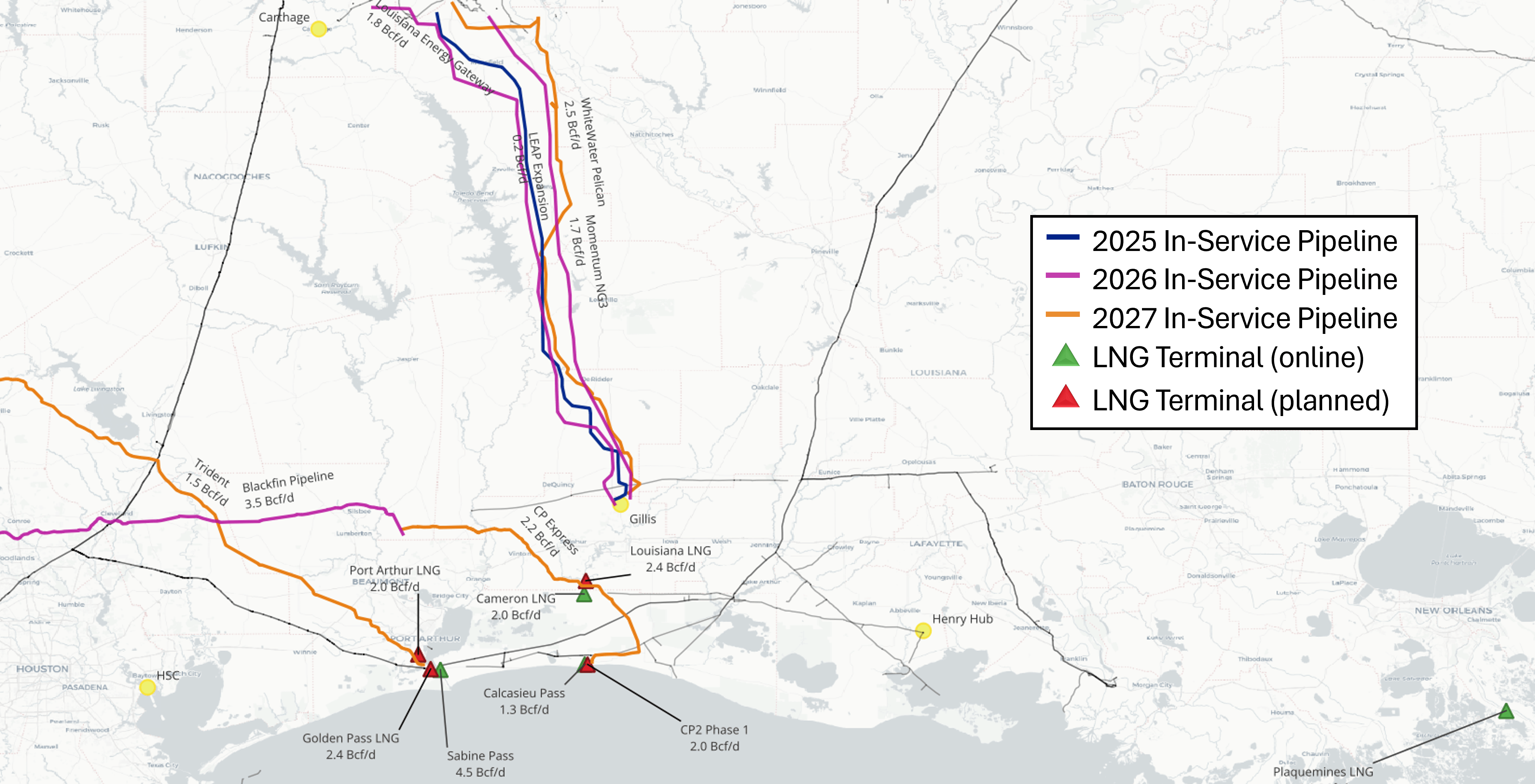
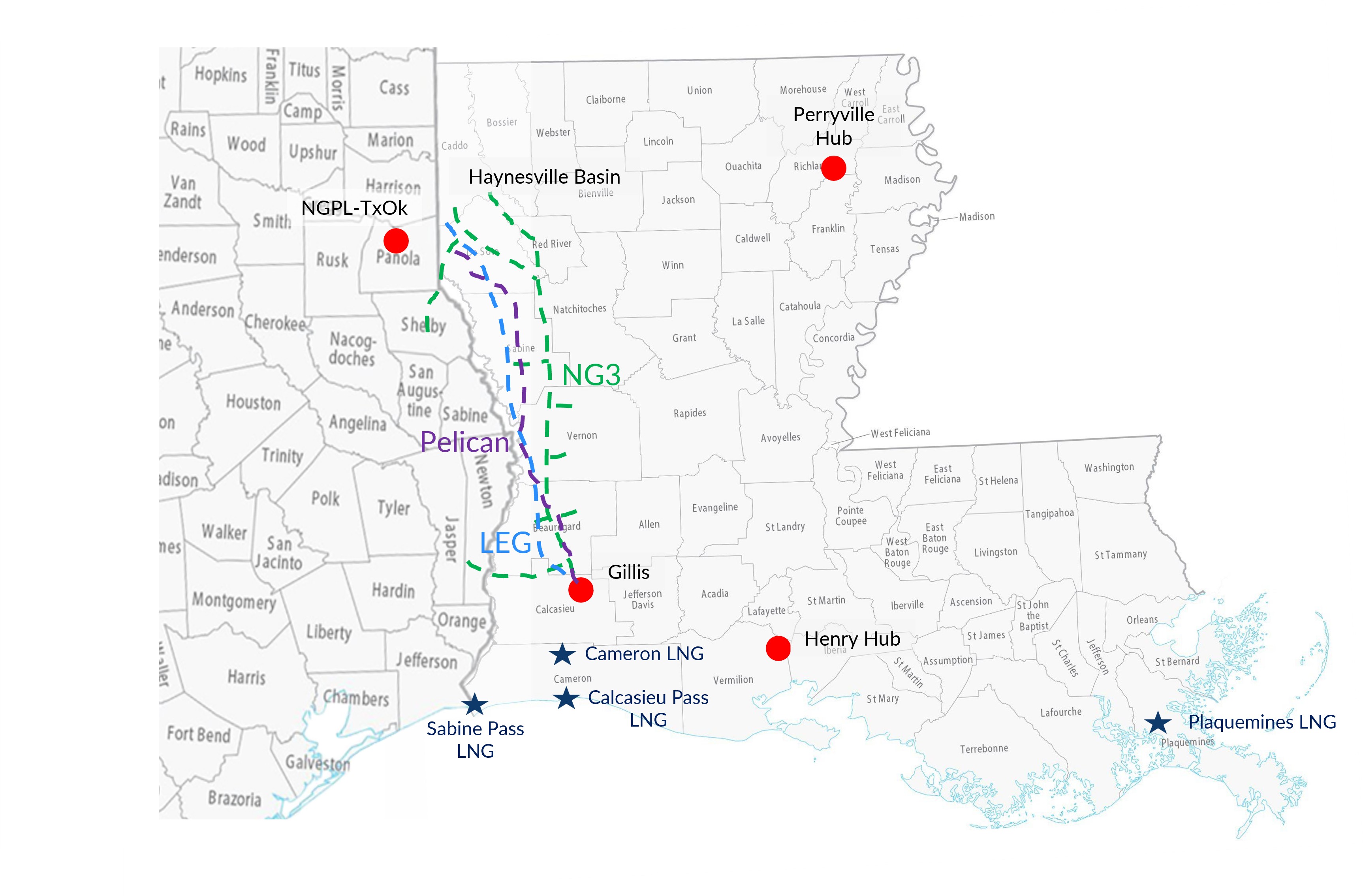
Gas Pipeline Projects
Louisiana Energy Gateway
In-service date: H2 2025
Capacity: 1.8 Bcf/d
|
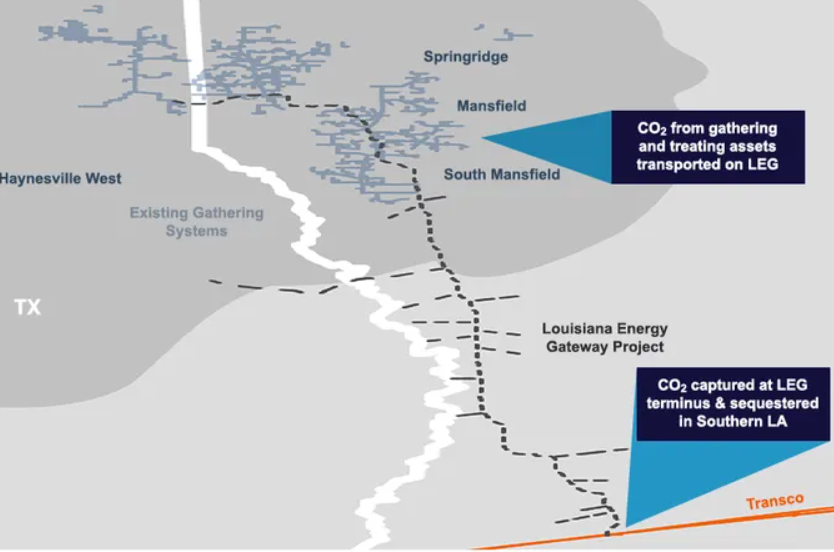
Source: NGI / Williams
|
|
|
Louisiana Energy Gateway - Williams’ LEG System will gather up to 1.8 Bcf/d from the Haynesville Shale formation and other natural gas production areas in Texas and Louisiana, and deliver to LNG export terminals and other markets along the Gulf Coast. The LEG System will be comprised of two segments: the Haynesville Spine and Juniper South.
|
New Generation Gas Gathering (NG3)
In-service date: H2 2025
Capacity: 1.7 Bcf/d
|
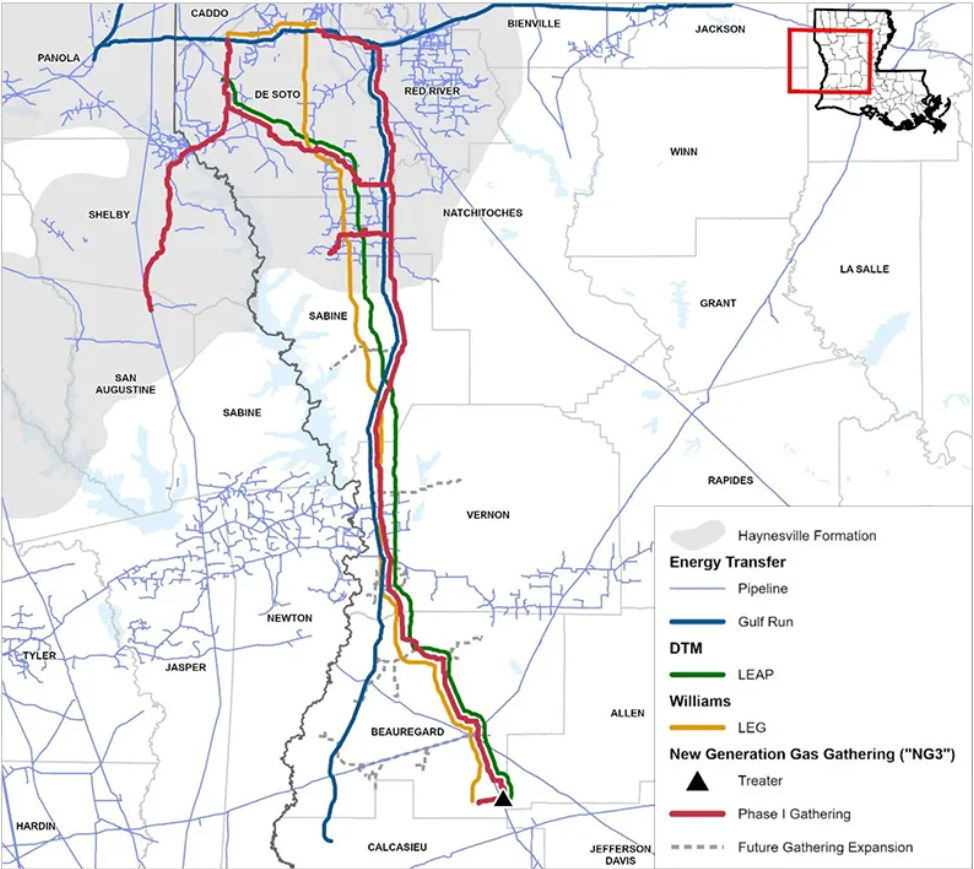
Source: NGI / 42nd Judicial District Court filling by New Generation Gas Gathering LLC
|
|
|
New Generation Gas Gathering (NG3) - Momentum Midstream will gather natural gas produced in the Haynesville Shale for re-delivery to premium Gulf Coast markets, including LNG export. With the final investment decision, the natural gas gathering and carbon capture project will have an initial capacity of 1.7 Bcf/d and is expandable to 2.2 Bcf/d. The project is expected to start service in December 2025.
|
LEAP Expansion Phase 4
In-service date: Q1 2026
Capacity: 0.2 Bcf/d
|
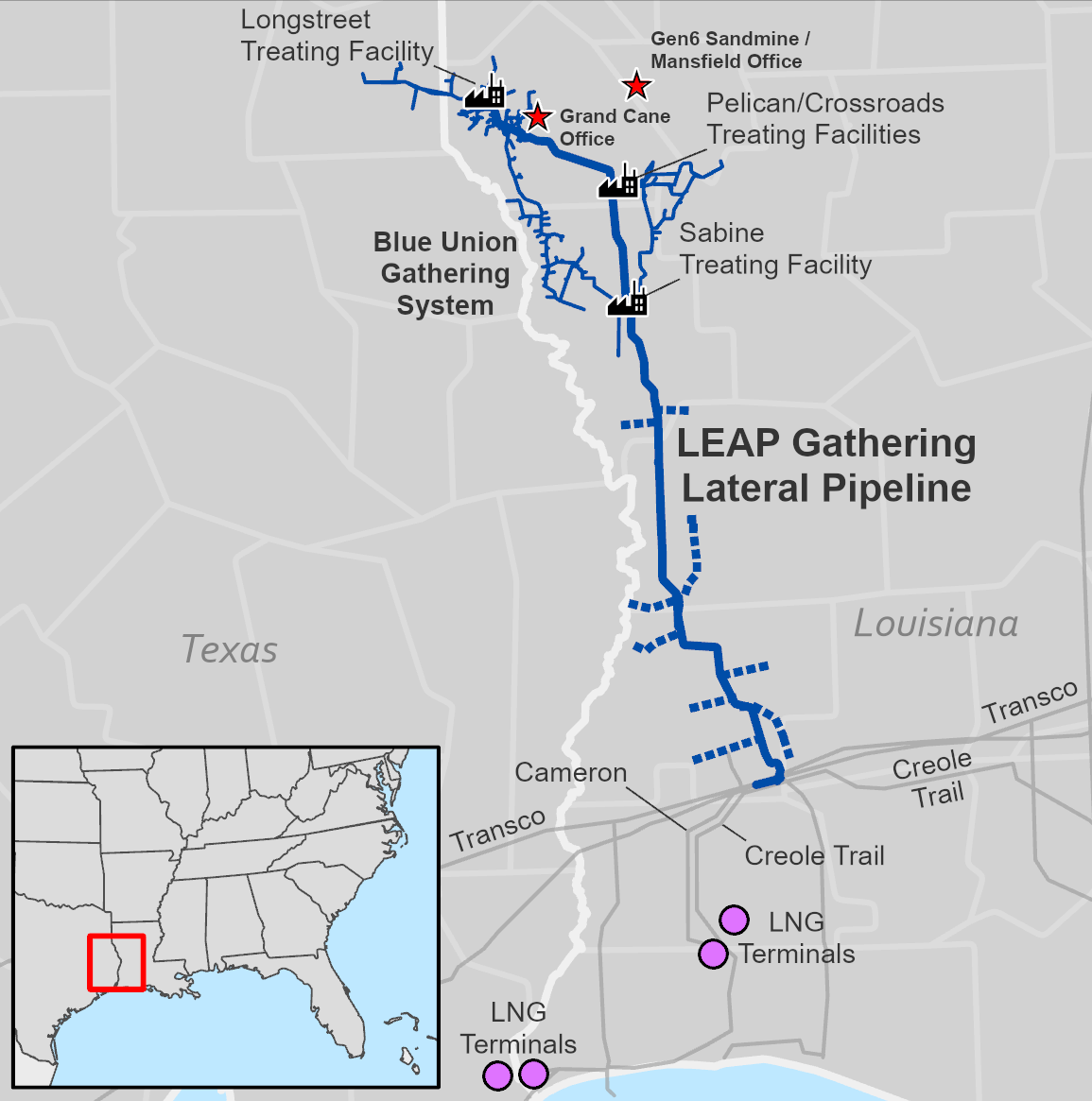
Source: DT Midstream
|
|
|
LEAP Expansion Phase 4 - Pipeline operator DT Midstream announced a final investment decision on another 200 MMcf/d expansion of its Louisiana Energy Access Pipeline gathering system, giving the project an in-service target of 2026 in line with projections of a wave of new LNG feedgas demand along the Gulf Coast.
|
Pelican Pipeline
In-service date: H1 2027
Capacity: 1.7 Bcf/d
|

Source: WhiteWater
|
|
|
Pelican Pipeline - The WhiteWater Pelican Pipeline will transport up to 1.75 Bcf/d through approximately 170 miles of 36-inch pipeline from Williams, Louisiana, to the Gillis Hub near Ragley, Louisiana. Expected to be operational in the first half of 2027, the pipeline project is currently pending necessary regulatory approvals.
|
Other Projects
|
|
Blackfin Pipeline - The WhiteWater Blackfin Pipeline is a 193-mile, 42-inch intrastate natural gas pipeline that will deliver up to 3.5 Bcf/d from the Houston Ship Channel to Jasper County in East Texas. From there, it will interconnect with Venture Global’s CP Express Pipeline, delivering feedgas to the CP2 LNG terminal in Cameron Parish, Louisiana. With CP2 expected to eventually draw more than 4 Bcf/d of gas, Blackfin will serve as a critical Permian-to-LNG corridor. Construction is underway, and the pipeline is expected to enter service in the third quarter of 2025.
NGPL TX-LA Expansion Project - The project will increase NGPL's capacity by approximately 0.3 Bcf/d. The project will primarily involve additional compression to increase natural gas deliveries from existing system receipts, the growing Haynesville and South Texas supply to growing LNG markets. The project is targeted to be in service by July 1, 2026.
Trident Pipeline - Kinder Morgan’s Trident Pipeline is a 216-mile, 2.0 Bcf/d intrastate system moving Permian gas from Katy, Texas, to the Port Arthur LNG corridor near the Louisiana border. By targeting demand from Gulf Coast export terminals like Golden Pass LNG, Trident introduces direct competition to Haynesville producers supplying the same markets. Trident is expected to enter service in early 2027, with capacity expandable to 2.8 Bcf/d.
|
Local Supply
|
Supply in the Haynesville should grow sharply over the next few years, with the region needed to serve the vast majority of new LNG export demand. Gas output fell during 2024 as a weak price environment forced producers to curtail production and reduce activity. Output has essentially been flat since this time, one year ago, but activity will need to ramp up soon if the new demand showing up this winter is to be served. The Haynesville rig count has ticked slightly higher in 2025, but drilling activity may need to pick up significantly.
|
|
Operator Guidance
Comstock Resources (Q3 2025 EC)
|
11/04/2025
|
|
2025 Guidance
Q3 2025 Production: 1.22 Bcfe/d
Q2 2025: 1.21 Bcfe/d → +0.8% QoQ
Q3 2024: 1.45 Bcfe/d → −15.9% YoY
Natural Gas & Oil Sales: $335 million
Operating Cash Flow: $190 million
Realized Gas Price: $2.75/Mcf
After hedging: $2.99/Mcf
Basis differential to NYMEX: $(0.32)/Mcf
Drilling & Basin Activity
Legacy Haynesville:
Wells Turned to Sales (YTD): 28 operated wells
Q3 D&C Costs:
Drilling: $558/ft (↓15% QoQ)
Completion: $671/ft (↓7% QoQ)
Western Haynesville:
Wells Turned to Sales (YTD): 8 operated wells
Q3 D&C Costs:
Drilling: $1,385/ft (↓24% QoQ)
Completion: $1,622/ft (↑24% QoQ due to deeper wells and higher frac horsepower)
Analysts Q&A Takeaways
Capital Efficiency:
Legacy Haynesville nearing peak efficiency
Western Haynesville still improving with new technologies and learnings
Marketing Strategy:
Midstream ownership enables direct sales to end users
Positioned near LNG corridor and AI/data center demand zones
Inventory Disclosure:
Conservative assumptions used for Western Haynesville
Unitization still in progress; future optimization expected
Industrial Contracts:
Open to long-term supply agreements with industrial customers
Direct sales seen as margin-enhancing
|
|
Expand Energy
(Q3 2025 EC)
|
10/29/2025
|
|
2025 Guidance
Q3 2025 Production: 3,206 MMcfe/d
Up 22% quarter-over-quarter (Q2 2025: 2,978 MMcfe/d)
Up 22% year-over-year (Q3 2024: ~2,617 MMcfe/d)
FY 2025 Guidance: ~3,000 MMcfe/d
Total Capex (Q3 2025): $416 million
Drilling & Basin Activity
Rigs Active: 7
TILs: 10 Haynesville, 15 Bossier
Spuds: 9 Haynesville, 8 Bossier
Breakeven: <$2.75/Mcfe (Haynesville-specific)
Down from ~$3.00 earlier in 2025
Driven by 25%+ well cost reductions and 30% lower costs vs. peers
Well Performance:
Average productivity ~40% above basin average
~20% of FY25 TILs exceed 1 Bcfe/1,000 ft
5% YoY improvement in well performance
Strategic Expansion
New Acreage: 75,000+ net acres acquired for $178 million
Potential to unlock >200 locations
Vertical appraisal well confirmed high-quality shale
First horizontal well scheduled for Q4 2025
Development approach remains measured due to geological complexity and long-term decline uncertainty
Cost Outlook:
Current Western Haynesville well costs: ~$3,000/ft
NFZ wells in South Louisiana: $1,500–$1,600/ft
Management expects Western Haynesville costs to trend lower over time
Analysts Q&A Takeaways
Capital Efficiency:
2026 Capex expected to remain flat at ~$2.85 billion
Includes appraisal spend for Western Haynesville
Flexibility to modulate production based on market conditions
Marketing Uplift:
Still in early stages
Tens of millions added to realizations year-to-date
Expect continued margin expansion through optimization and structured deals
|
|
|
| |
Local Demand
|
While gas consumption in Northern Louisiana, where most production is located, averages only 500 MMcf/d per month, the source of almost all US gas demand growth is directly to the south. LNG buildout in Southern Louisiana should drive growth in gas demand for the next few years. In addition, the Southeast region as a whole should see continued electricity demand growth, supporting gas-fired power burns.
|
|
LNG
LNG feedgas will drive demand growth in Southern Louisiana going forward, and has already led to significant changes in gas flows and pricing. The majority of constructed and planned LNG export plants are situated near the border of Texas and Louisiana, in close proximity to Haynesville supply. Venture Global's Plaquemines LNG is the latest facility to enter service, with the plant ramping up to its full capacity over the next several months. Feedgas flows into the four currently operating Louisiana export plants can be seen in the charts below, in addition to the planned facilities.
|
|
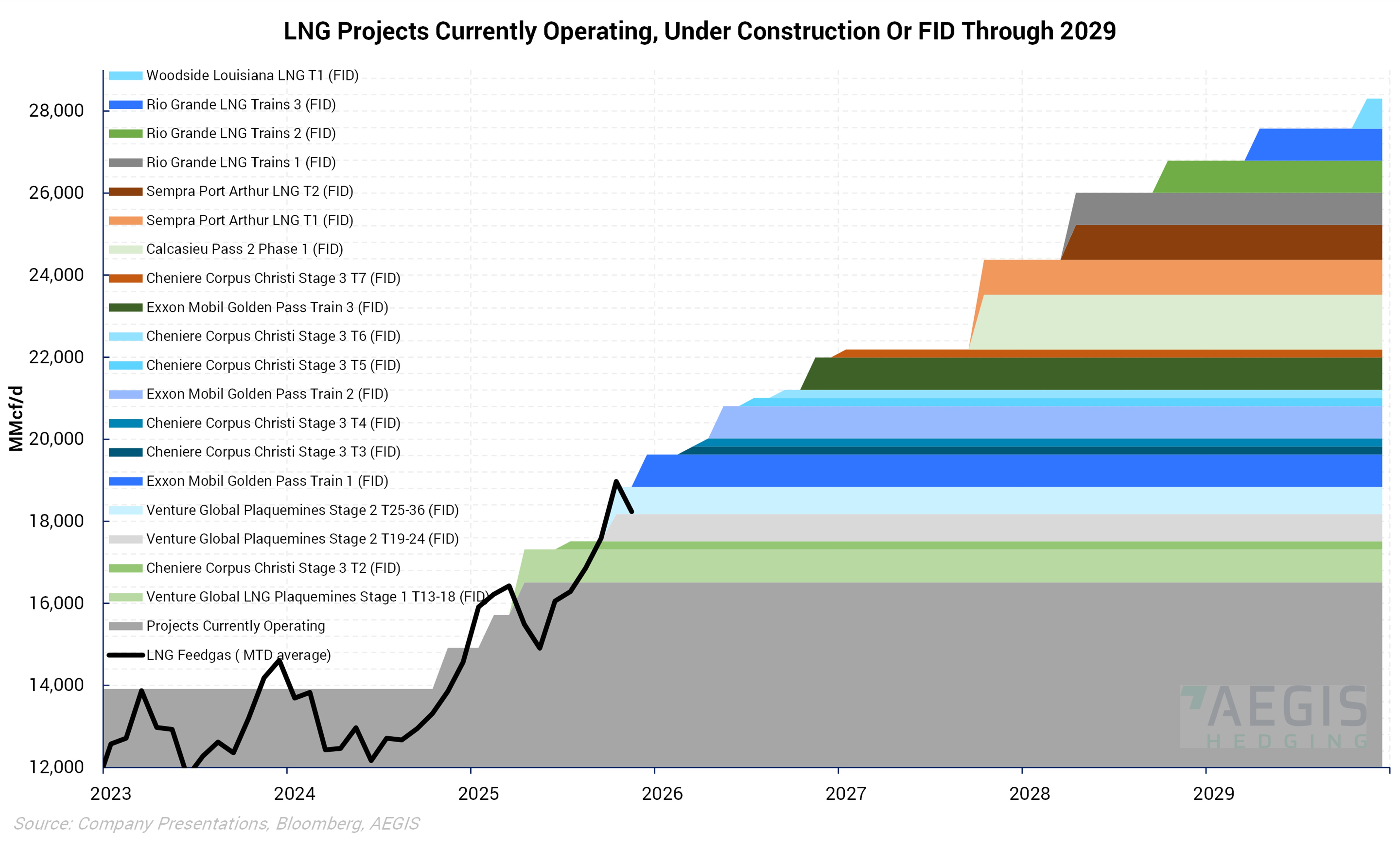 |
Chart Packet
|
Recent Market-Relevant Events
NG3 Pipeline Begins Flows, Boosting Haynesville Gas Egress to South Louisiana
(September 4, 2025)
Market Impact: The 1.7 Bcf/d New Generation Gas Gathering (NG3) pipeline has begun flowing gas south from the Haynesville, connecting into TC Louisiana’s intrastate system at Beauregard near Gillis
-
Initial volumes started at 100 MMcf/d on Aug. 27 and climbed to ~300 MMcf/d in early September, slightly ahead of schedule
-
NG3 adds to new egress capacity from Williams’ 1.8 Bcf/d Louisiana Energy Gateway (LEG), which began service in July, both targeting Gulf Coast LNG markets
-
NG3 is jointly developed by Momentum Midstream and Expand Energy, which owns a 35% stake
|
Louisiana Energy Gateway Begins Gas Flows
(July 29, 2025)
Market Impact: Delfin Midstream has secured key agreements with Siemens Energy, and others as it prepares for a final investment decision (FID) this fall on its first floating LNG (FLNG) export project, located 40 nautical miles offshore Cameron Parish, Louisiana
-
The pipeline has a total capacity of 1.8 Bcf/d, with data from S&P showing about 250 MMcf/d flowing off of Transco onto the pipe on July 29
-
The in-service date for the pipeline had been delayed previously, due to a legal dispute over
-
Flows should increase over the next year as production in the Haynesville ramps up and demand in southern Lousiana continues to climb
|
Delfin LNG Secures Contractor Deals Ahead of Fall FID for First Floating LNG Vessel
(July 3, 2025)
Market Impact: Delfin Midstream has secured key agreements with Siemens Energy, and others as it prepares for a final investment decision (FID) this fall on its first floating LNG (FLNG) export project, located 40 nautical miles offshore Cameron Parish, Louisiana
-
The first FLNG unit would have a capacity of 4.4 million mtpa/year, part of a broader 3-vessel plan totaling 13.2 million mtpa/year
-
2029 delivery timeline for the first FLNG vessel
-
Delfin locked in gas turbine manufacturing capacity and launched early design work, anchoring a 2029 in-service timeline
-
Delfin is the first U.S. FLNG developer to near FID, signaling potential for modular, offshore LNG growth, a new export architecture compared to traditional Gulf Coast mega-terminals
|
|
|

Don’t stop here.
See how other regions are performing right now:
|

